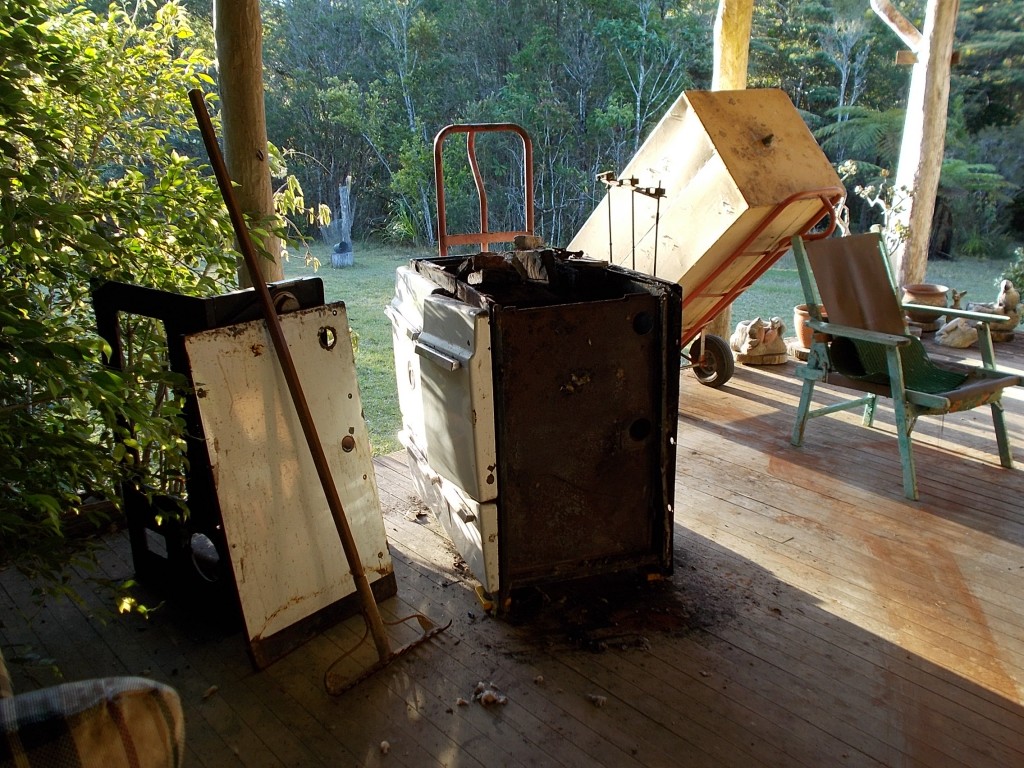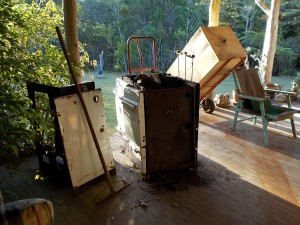
It is springtime. In England, where I come from, it was traditional at the first sign of spring to throw the doors open, let the air and light in and give the house a thorough clean to rid the house of the house of accumulated dust and mold from the dark clammy months of winter. A sort of cathartic experience and a renewal of life. Spring-cleaning was a well established tradition which I eagerly sought to avoid. Not only was it drudgery of the worst kind, but it was suddenly announced to unsuspecting kids on the best and sunniest day we had seen for months and months. A day that should have been spent wandering in woods, fishing or even seeking the attention of the latest heartthrob. Instead it was wasted in the mind-numbing ritual of beating carpets on the clothesline.
Here spring in Possum Valley is lovely with the sarsaparilla trees in full yellow bloom, the hum of bees feasting on them and balmy days of warmth and sunshine. The “Lady Slipper” vine is in full flower, the frogs are croaking their amorous interests and an orchid near the house displaying its wares.
So in an act of rebellion, I decided to have a ‘spring-dirty’ event in revenge for precious days robbed from my childhood. I was going to uninstall the slow combustion stove. Uninstall these days means a few key-strokes, but what I am talking about is orders of magnitude more difficult. To completely remove a system of water heating, cooking, chimneys, plumbing etc that the house was built round.
The slow-combustion stove itself is a quarter ton monument of iron and bricks that had rusted away to a state of dysfunction. The doors didn’t close, the hotplate was corroded to resemble the moon, the fire controls had disintegrated but worst of all was the smoke that filled the house for hours as I tried to light it. Because internal passages had clogged/collapsed and unexpected channels for air ingress and smoke egress had appeared, most of the smoke took alternative ways to exit. I had to reluctantly conclude that the stove had reached the end of its useful life.
Not that I’m complaining. I bought it for $150 about 30 years ago and it was in continual 24/7 use for all but the last 3 years. I then was given an electric water tank by a friend (thanks Martin) and puzzled out how to dump the unused power from the hydro into it. The left-over electricity was snaggy little spikes of a sine wave and could vary from 0 to 240 volts depending on what else was being used. But you can put that into a pure resistance and it doesn’t care. But I couldn’t dump all the power the hydro governor dumped, otherwise the tank would boil and and frequently dump steam, as well as the safety hazard of boiling water and steam coming out of the taps. Some internet research turned up the circuit diagrams of the tank thermostat (surprisingly complicated with 12 terminals as a multi-function device), and Wikipedia turned up the diagrams for a large range of relays. By running 24V DC through the thermostat instead of 240V AC, I was able to operate a relay to switch the dumped power from the tank to a 2 bar heater which has been the dump load for the last 30 years and is currently beaming down on my back. The hydro generator needs a load at all times otherwise the volts go up to about 400 and when something is switched in, bad things happen. Grey smoke and a sound like sizzling bacon comes from the poor unsuspecting gizmos.
In the 3 years since I rigged up this effortless way to get free and abundant hot water, I got suddenly lazy. I found it quite easy to give up cutting trees down, sharpening chainsaws, cutting into stove sized lengths, disposing of the small branches and leaves, loading it onto my ute and hauling to the house, stacking it to dry, splitting it, re-stacking, carrying it into the house every eight hours, monitoring the embers, taking out the ash, cleaning the chimney, de-clogging the stove passages, etc. All heavy duty, dirty chores. Oh, I nearly forgot the ritual of going to the Forestry Department for a firewood licence. The cost was not the problem, from $5 in 1985 rising to $7.50 a few years ago for as much firewood as you could cut and haul in a month. Potentially a 100 tons. No, the problem was increasing paperwork and restrictions. About 15 years ago the bureaucrats decided I needed a certificate to operate a chainsaw. Level 2 tree felling. I was on the day course near Ravenshoe with about 10 people. Two of them had operated the first chainsaw ever to come to the Tablelands and worked in the timber industry for decades, not a thing thing these old-timers didn’t know about felling trees, but they still needed the paperwork. To demonstrate our competency, we each had to fell about 15 trees in specified ways. How environmentally friendly is that? Anyway, the choice between all of the above and effortless hot water was easy to make.
The stove supplied hot water stored in a 50 gallon tank in a small room where the linen and towels are kept on shelves. I knew I had to remove a set of shelves to get it out. No problem. I carefully measured the tank and found it was larger than the doorway. By removing the doors and door frame, I thought I had 2mm clearance. Otherwise I would have to demolish half the house. Actually I had no clearance and left a smear of paint on the studs as I shoved it through. 30 years of sludge trailed across the floor as I wheeled it out. The tank was also bought second hand for $50 I think, but from a different source than the stove. It bore an impressive brass plaque embossed with the certificate of inspection for October 1954. Anybody need a tank? I modified the plumbing in the house and removed a header tank from the roof, patched holes in the walls where heating pipes had been, sanded and varnished the floor which had been under the stove and had not seen the light of day for 30 years.
Yet I have pangs of regret. I have to admit that I have been somewhat of a survivalist, being brought up in the cold war and the nuclear missile age. I like hybrid systems and alternative ways of providing the necessities, and now I have reduced my resources. But the stove was well and truly stuffed. I liked the gentle heat the stove added in the winter, and the focal point it provided when the family would shuffle up and park their bums on it. Also perhaps something more ancient, providing the family hearth, and the fire essential to cooking and warmth gave me validation as the provider. Ah well … all gone.

How about a new (or used) stove Paul…. If you need a hand putting it in, let us know …